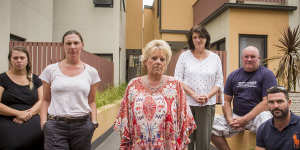Joshua McDonald,a senior forensic engineer at Roscon,a company specialising in identifying building flaws,said a lack of oversight in the construction industry was fuelling a legacy of defects,including cracked foundations,balcony defects,flammable cladding,water leaks and black mould.

Firefighters inspect the damage at Melbourne’s Neo 200 building in 2019.Jason South
“Apartment buildings are being swept up by developers for as cheap as they can get;they’re using cheap materials and cheap finishes,” he said.
“Often these apartments will last about 10 years before you need major works done,and then that’s all on the owners because there’s no legal recourse.”
McDonald is one of a growing number of industry experts demanding legislative change and the introduction of tough criminal penalties for builders,developers or surveyors caught committing acts of deliberate malpractice.
“There should be criminal consequences,not just fines,” said McDonald. “There should be a whole range of consequences depending on the severity of the offence.”
Currently,builders caught flouting the law face being or having their licence suspended for certifying uncompliant work,but McDonald said it was not enough of a deterrent.
“There’s no real consequences,” he said.
Frankston South apartment owner Kerry Ould said government-funded works to replace potentially dangerous cladding had finally been completed at her home last week,after years of delays.
But Ould,whose apartment complex was riddled with combustible cladding and deemed “urgent or high-risk”,is now having to fund more than $70,000 worth of repairs for defects identified during the rectification works,including rotting wood.

Frankston South apartment owner Kerry Ould (centre) in 2019 with her neighbours. Government-funded works to replace potentially dangerous cladding were finally been completed at her home last week.Paul Jeffers
“It’s been seven years of this crap,” said Ould,who has spent her life savings on her apartment.
Association of Consulting Architects Victorian president Paul Viney said the state’s cladding crisis had exposed a wave of subsequent flaws uncovered in the walls of defective apartment blocks.
“The problem we’ve got is that now we’ve got a plethora of waterproofing issues,” he said. “It is a very significant issue we’re facing. It’s endemic. You’ve got to ask,‘Why is this occurring?’ We believe it requires legislative change.”
Viney said Victorian builders were not required to provide insurance for a building once they were above three storeys,and were required to have only a 12-month defects liability period.
“Then they will walk out the door,” he said. “It’s leaving a whole legacy of issues for body corporates.”
Viney wants Victoria to take a similar approach to NSW,which mandates that apartment designs must be prepared by experts before they are submitted for a building permit.
“In Victoria,the design-construct process means you can get an architect to carry a design through to a very basic level,then what’s been happening is that detailed design is being handed off to contractors and not consultants,” he said.
“None of them are registered. None of them have the appropriate qualifications to carry through the works. They have a vested interest in minimising the amount of work that’s been done.”
are riddled with construction flaws,consumer advocates also fear a rescue package aimed at removing flammable cladding from thousands of buildings may run out of funds before completing promised works on about 90 high-risk buildings.
Builders Collective of Australia president Phil Dwyer said the government had “grossly underfunded” a $600 million rescue package announced in 2019 in response to buildings earmarked as potentially dangerous,after a spate of fires in buildings covered in combustible cladding.
“We estimated at the time it was about a tenth of what was required to fix this mess,” he said.
The government maintains it has adequate funding to complete the program by the end of 2025.
The NSW government says there is no danger to the residents of four Sydney apartment blocks where significant defects have been found.
But industry sources with expertise in Victoria’s cladding crisis estimated that even if only “extreme and high-risk” buildings were fixed,each building could cost anywhere between $3 million and $6 million to fix,blowing out the total cost of addressing the problem to between $1.24 billion and $2.5 billion.
McDonald,who has so far inspected about 1500 buildings with defects,said it was impossible to quantify the magnitude of the defects in Victorian apartments,most of which were built in the past 30-or-so years.
“There would be many thousands impacted to varying degrees,” he said.
McDonald said while the government had rightly acted to address energy efficiency in new apartments,this had sparked a slew of condensation issues being fuelled by a lack of waterproofing regulation.

“We’re sealing up every single gap between the outside and inside apartments,and that lack of being able to transfer air creates the likelihood of condensation,” he said.
“If there’s no way for that to drain or evaporate,it creates moisture. Moisture creates mould. Suddenly,you have serious health issues for the residents because they’re living in mould-infested apartments.”
McDonald attributed the problems in apartments to the privatisation of the building industry in the 1990s,in which,once a staple of local council responsibilities.
“Back in the day,there used to be a system of certification,where councils employed independent building surveyors,and they checked,ticked off and all approved works,” he said. “These days,it’s all self-certified.”
He said the issue had been fuelled by a lack of compliance and policing,estimating that the Victorian Building Authority only audited a small percentage of all jobs.
“As a result,people are taking shortcuts,they’re cutting corners,and we’re seeing chronic and systemic issues,” he said.
In its most recent budget,the state government set aside $63 million for a building reform package to strengthen oversight of the construction industry.
It said the package would also strengthen the Victorian Building Authority by boosting inspectors and auditors by 50 per cent,as well as funding improved technology and intelligence to better protect consumers.
The authority’s new chief executive and commissioner,Anna Cronin,is overseeing a program aimed at improving the performance and culture of the regulator. The authority has also released a new regulatory policy statement,which has increased its focus on consumers.
The government is weighing up further changes to ensure the regulator is fit for purpose,including the possibility of giving it additional powers.
Following the collapse of Porter Davis last year,the government passed legislation on new offences for builders who accept deposits from consumers without taking out the required insurance. Under the new act,builders will face penalties of up to $96,000 for an individual or $480,000 for a company.
Get the day’s breaking news,entertainment ideas and a long read to enjoy.